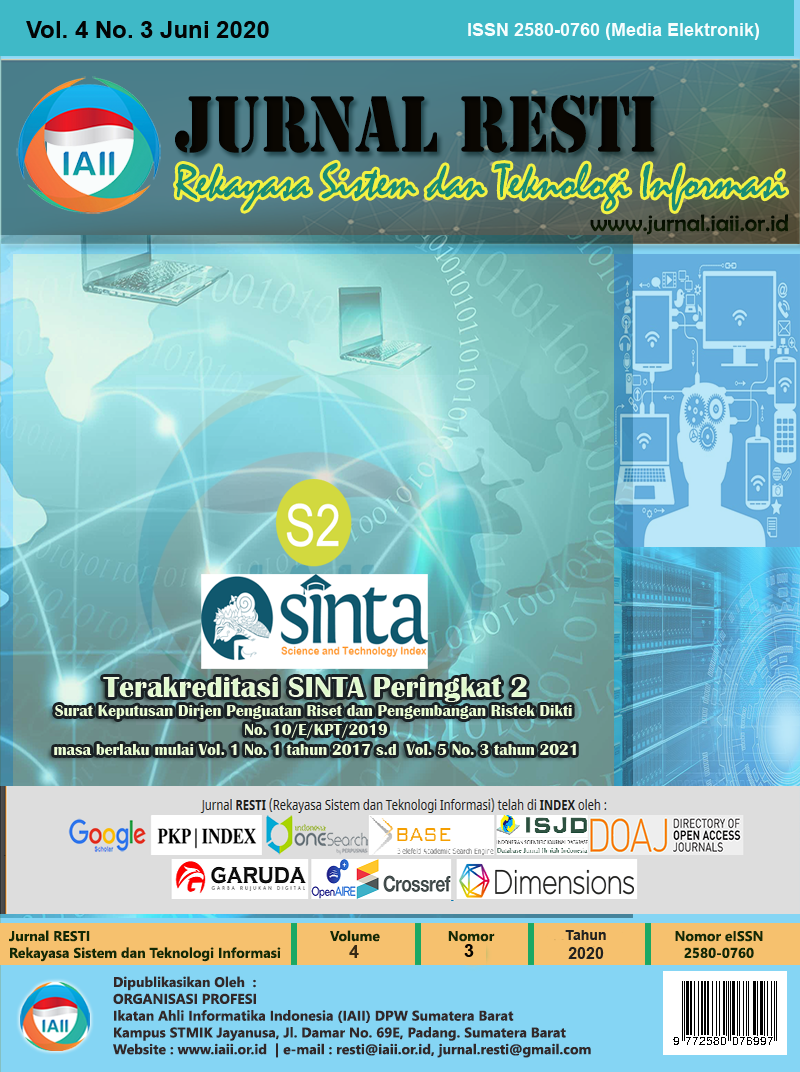Prediction Vulnerability Level of Dengue Fever Using KNN and Random Forest
Prediksi Tingkat Kerentanan Demam Berdarah Menggunakan KNN dan Random Forest
Abstract
Indonesia is a country that is prone to Dengue Fever, this happens because Indonesia is a country with a tropical climate. More than 50 years after Indonesia contracted the dengue virus, dengue fever cases have not been resolved, currently the cases that occur are greatly increased over time this happens because of factors that cause dengue fever. By considering this serious problem, the authors created a system that can predict the vulnerability level in Bandung and looks for the factors that most influence from all factors of Dengue Fever using the KNN Algorithm and Random Forest. The results of the system show the results of the best model is KNN algorithm with RMSE 29,26, and from the model shows the most influencing factors are population density, growth rate population mobility, rainfall, wind speed. by utilizing the results of the study, the government can adjust actions to each level of sub-district vulnerability and pay more attention to the factors that most influence dengue fever according to the results of the study.
Downloads
References
Z. Istiqomah, “Dinkes Kota Bandung Catat Peningkatan Pasien DBD,” REPUBLIKA.co.id, 2019. [Online]. Available: https://www.republika.co.id/berita/nasional/daerah/19/01/28/pm17ip335-dinkes-kota-bandung-catat-peningkatan-pasien-dbd. [Accessed: 02-Dec-2019].
Y. Jiang, G. Zhu, and L. Lin, “Research of dengue fever prediction in san juan, puerto rico based on a KNN regression model,” in Lecture Notes in Computer Science (including subseries Lecture Notes in Artificial Intelligence and Lecture Notes in Bioinformatics), 2017.
J. Ong et al., “Mapping dengue risk in Singapore using Random Forest,” PLoS Negl. Trop. Dis., 2018.
A. L. Buczak et al., “Prediction of High Incidence of Dengue in the Philippines,” PLoS Negl. Trop. Dis., 2014.
S. S. Prasetiyowati and Y. Sibaroni, “Prediction of DHF disease spreading patterns using inverse distances weighted (IDW), ordinary and universal kriging,” in Journal of Physics: Conference Series, 2018.
J. Xie, W. Jiang, and L. Ding, “Clustering by Searching Density Peaks via Local,” 2017.
L. Y. Hu, M. W. Huang, S. W. Ke, and C. F. Tsai, “The distance function effect on k-nearest neighbor classification for medical datasets,” Springerplus, 2016.
A. Mucherino, P. J. Papajorgji, and P. Pardalos, Data Mining in Agriculture. Springer-Verlag New York, 2009.
A. Liaw and M. Wiener, “Classification and Regression with Random Forest,” R News, 2002.
G. James, D. Witten, T. Hastie, and R. Tibshirani, “An Introduction to Statistical Learning with Applications in R,” in An Introduction to Statistical Learning with Applications in R, Springer, 2013, pp. 308–310.
T. Chai and R. R. Draxler, “Root mean square error (RMSE) or mean absolute error (MAE)? -Arguments against avoiding RMSE in the literature,” Geosci. Model Dev., 2014.
Indrabayu, N. Harun, M. S. Pallu, A. Andani, and F. C.L, “Prediksi curah hujan dengan jaringan saraf tiruan,” Gr. Tek. Elektro, vol. 6, pp. 978–979, 2012.
U. F. Achmadi et al., “Buletin Jendela Epidemiologi,” Kementrian Kesehatan Republik Indonesia, vol. 2, no. Demam Berdarah Dengue, Aug-2010.
Copyright (c) 2020 Jurnal RESTI (Rekayasa Sistem dan Teknologi Informasi)

This work is licensed under a Creative Commons Attribution 4.0 International License.
Copyright in each article belongs to the author
- The author acknowledges that the RESTI Journal (System Engineering and Information Technology) is the first publisher to publish with a license Creative Commons Attribution 4.0 International License.
- Authors can enter writing separately, arrange the non-exclusive distribution of manuscripts that have been published in this journal into other versions (eg sent to the author's institutional repository, publication in a book, etc.), by acknowledging that the manuscript has been published for the first time in the RESTI (Rekayasa Sistem dan Teknologi Informasi) journal ;








